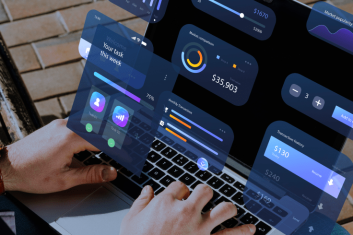For many people, managing personal finances is a struggle. Keeping track of every transaction is time-consuming and difficult.
Financial management software helps by automating the process, but what qualities make personal finance apps truly useful?
In this article, we will discuss the benefits of financial apps, describe their best features, and walk you through the process of building one.
Want to develop your own finance management app?
HQSoftware provides the expertise you need to build the project. Let’s collaborate!
Andrey Kazakevich
Head of Production
at HQSoftware
How many people use personal finance apps
According to Think with Google, 73% of smartphone users report that they use apps to manage their finances.
On average, smartphone users have more than 2 financial apps installed.
Some of the most popular apps for managing finances are Mint, Credit Karma, Robinhood, and Level Money. These have gained traction with their respective user bases by providing a high-quality experience and unique features.
So, financial apps are in great demand right now.

Why people use personal finance apps
Put simply, financial management apps help people control their finances.
But there are additional benefits. Let’s take a look at what else users get from financial software:
Users set financial goals and reach them
It doesn’t matter if you are rich, have an average income, or are just trying to make ends meet. A good financial planner will always come in handy.
Financial planning provides clarity; it allows you to identify your financial goals and find ways to reach them. Here are some examples:
- Paying off debt. Build a strategy to get rid of all the debt that’s weighing you down.
- Save more. Choose how much you want to save and build up a financial cushion.
- Build an emergency fund. Be sure you have enough to get by, no matter what.
- Learn how to invest. Let the technology behind your financial management app teach you how to invest money the right way.
A powerful planning app can help you reach any financial goal you want.
Users become more confident with their finances
Probably everyone has been in the situation of worrying about whether they’re spending too much or saving enough.
Finance management apps help users avoid unnecessary worry by letting them monitor their financial status on a daily basis and see how much money they have to spare before the next paycheck.
Users develop healthy spending habits
We all tend to spend money irresponsibly sometimes; it’s okay to admit that. But developing good spending habits is a must when you want to control your financial well-being.
Personal finance money management apps help users become more disciplined in their spending by analyzing daily income and outflow and alerting users when they are spending too much, or when there is too much impulse buying.
Users have a useful accounting tool at hand
Accounting is a complex process usually done by a skilled specialist. But for most people, personal accounting can be automated and fit in your pocket — in your smartphone app.
Financial management apps can do personal accounting easily, including keeping track of:
- Fixed assets
- General ledger
- Accounts payable/receivable
- Bank reconciliation, and more.
These are the most common benefits that apps for tracking personal finances provide. They are determined by the app’s functionality, which we will discuss later.

Now let’s talk about what features you need for an MVP — the very first version of your future financial app.
MVP features in Building the Finance Management App
Your very first step in personal finance app development is to test the validity of your idea by developing an MVP (minimum viable product).
This is a version of your app that contains only the most important and vital features. They typically include the following.
Real-time dashboard
Real-time updates on how you receive and spend your money help you keep an eye on your financial status.
Financial app developers build this feature for an MVP version because often it is the core feature in financial planning applications.
The application accesses your bank accounts and updates all transactions automatically. The user no longer needs to enter them manually.

Account aggregation
If you have several accounts in various banks, it can be complicated to keep track of your money. Personal finance tracker apps solve this issue with ease.
This kind of app will aggregate all accounts in one place, allowing you to see what’s going on with all of your debit and credit cards, loans, and bank accounts.
Spending categories
It is easier to find out whether you’re spending too much money on a particular type of goods or services when your financial planning app can automatically filter expenses by category.
Built-in categories make it a lot easier to plan a budget, and this is why this feature needs to be in the MVP.
Spending analysis
This feature will help users keep their expenses under control. Impulsive buying and irresponsible spending are the top reasons why people can’t seem to save.
A good MVP should track all expenses automatically as well as allow for manual entry, for example of cash transactions.
Alerts and notifications
The user should be able to set notifications about timely payments, to avoid penalties. An MVP of a finance planning app should allow for setting notifications for the following situations:
- Balance is low
- Suspicious card or bank account transactions
- Overspending
- Upcoming planned or mandatory bills

Once we have figured out what kinds of functionality are a must for an MVP, let’s take a look at features that the best personal finance apps should have going forward.
Must-have features in money management apps for 2021
These features can be called advanced because they are totally optional — a financial management app can go without them just fine.
But as new technology emerges, smartphones have more computing power, and no one will be impressed by simple apps anymore.
So what to do?
Add some advanced features, of course. Here they are:
Built-in calculator
This feature is useful in many situations — when you want to figure out how to split a bill, sum up how much cash you have, or figure out how much interest you’ll pay on a loan.
Converter for currencies
This is important for those who have bank deposits in different currencies, plan to travel abroad and need to exchange money, or just want to exchange some money in cash.
Tax calculator
Some countries have complex tax policies that require citizens to figure out their taxes themselves. A fault-free app that can automate all tax calculations will be extremely popular on the market.
Custom shopping lists
Another cool feature is the ability to create a shopping list inside the financial planning app, estimate how much it will cost, and eventually add it to expenses.
Credit calculator
Calculating the cost of a loan or payments on a line of credit may be tough, taking into account how complicated credit requirements and terms may be.
If an app that can obtain data on a credit opportunity from the bank’s website and automatically estimate payments, users will definitely love it.

There are plenty of fintech apps on the market, but some really stand out.
What features do they have for a competitive advantage? Read on to find out.
Features that may give your financial management software a competitive advantage
Now let’s talk about how popular money management apps gained their competitive advantage.
Affiliate programs
Mint has developed an interesting approach to monetization.
The service did not choose to put ads on the app, though it is the easiest way to earn money when the application has such a huge audience.
Their approach is different. Mint analyzes users’ financial histories and recommends partners’ products.
The recommendations generate revenue and improve the user experience at the same time, which is different from traditional ads that only generate revenue.
For example, the app analyzes how you spend money and sees that you have spent around $200 paying phone, TV and Internet bills last month. The app will then offer you a partner’s bundle for $99, which will save you up to $1300 a year.
Isn’t that impressive?
“Invisible” saving tools
The financial management application Digit has come up with a feature that everyone loves — automated savings.
The app solved a perennial problem for users — making sure to tuck away some savings, regularly and painlessly.
The app analyzes your spending habits, predicts your needs and income, and transfers a little part of the predicted remainder to a special account, daily.
It’s claimed the algorithm is pretty accurate. The company even offers overdraft prevention services and reimbursement guarantees, so that users are always protected.
Digit claims that the average user saves at least $2,000 per year.
Artificial intelligence
Benefits can come from applying AI to financial management.
For instance, spending analysis can give the user advice on how to optimize their finances.
Another great feature is fraud prevention: by analyzing transaction information, AI may be able to recognize suspicious activity in accounts quickly.
Accessible financial advice
Financial consulting is an expensive service that not everyone can afford. Yet it is often invaluable in helping people tackle their financial issues.
The application Albert makes financial consulting easier to get and afford.
This is a financial management app that provides investment advice and financial planning tools. The majority of features are free to use, though there is a subscription that allows users to connect to financial advisors who provide consulting on financial objectives.

Many applications and features that we have already described require access to sensitive personal and bank account information.
It might seem risky to disclose such information to a third-party app.
Then how do these apps provide security? Let’s find out.
Financial app security
When it comes to personal data security, quality financial apps are doing their best to prevent data leakage, account break-ins, and other illegal activity.
Here are some ways financial apps are currently using to provide security:
Two-factor authentication
This method of data security is one of the most simple, yet efficient.
Two-factor authentication works this way — in addition to a traditional way of logging in via login and password data, the app requires a second factor.
This may be your phone number or an email, a code card, or some sort of a physical key.
For example, when the user tries to access the app, the user must enter a code sent via SMS.
This level of security is a must for nearly any app today.
Data Encryption
Encryption is a method of data encoding that turns data into a code. When it is time to read it, the data requires a certain key to decipher it.
Some popular encryption mechanisms include:
- Twofish. Encrypts data into 128-bit blocks.
- RSA. Asymmetric algorithm with public and private encryption keys.
Short sessions
Bank applications usually do not keep you logged in for very long, for security reasons.
Unlike in Google or Facebook, you will have to login every now and then, because insufficient session expiration increases the vulnerability of data and overall app exposure to session-based attacks.
The hacker may be able to reuse a valid session ID and interfere or seize it.
This is why session expiration timeouts should be short and set according to the type of financial application. The most common session interval for high-risk apps is no longer than 5 minutes.

How to develop a personal finance app
The very first thing to do when planning to develop a personal finance app is to gather information. You have to decide the value of your software solution: what problem will it solve for users?
But determining the value of the app can be tricky: you might miss the mark completely and lose the audience.
So here’s what you should do to make a truly useful personal finance app.
Audience research
Analyze your potential users; see what problems they have with managing finances and what solutions you can offer.
Based on that research, you will be able to come up with a list of features that are essential to your finance app and even build the design of the solution that offers the most convenience to the user.
Specification
The next step is structuring the data from the research and coming up with the specification. This document will include your ideas for the finance management app: its design, features, required technology, and so on.
Since creating a specification requires some technical knowledge and experience in business analysis, not everybody can do it correctly.
But don’t worry — all that matters now is getting your ideas down. You will work out the details later with the help of your software development team.
Hiring a software development team
Now you can look for a software vendor to help you bring your project to life.
It may be hard to find a company with experience in developing money management apps.
Here’s the simple pathway to finding and hiring a financial app development company that will deliver the project:
- Use Google search, research agencies’ listings and referrals to look for a list of suitable companies;
- Gather information on their expertise: check testimonials, their website, and portfolio to see if they’re the right fit for you;
- Negotiate the terms of your cooperation and choose the appropriate collaboration model: fixed-budget, time and material, or dedicated team.
The development process
Then you will work with the company’s Business Analysts and Project Managers to flesh out the project specification, which includes:
- deciding on the budget and financial feasibility of the project;
- working out the timeframe of the project;
- choosing the appropriate technology.
When the preparation work is done, you will have to test the idea. The team will build an MVP with some of the most essential features of the software, to see how it works.
Based on the MVP’s performance, some adjustments should be made to the strategy.
And then, the main stage of the project begins.
Now you will have your software development team working on a project. The Project Manager breaks the project down into tasks, oversees the developers’ work, and keeps you updated on the progress.
After the solution is ready, the testing process begins. QA testers check the financial planner app to be sure it works correctly and performs well on different devices.
Product release
Before going with a full-blown release, it is best to put out the first version of the planner app to a limited number of users. This way, you can get fresh feedback on the app and pull it quickly to solve issues the developers might have missed.
After that phase, your personal finance app is ready. You are free to release it to the public and maintain the service.

How much does it cost to create a budget planner app?
The costs of developing a money management app can vary greatly, based on many factors.
The best way to get a rough estimate is to look at all of those factors.
The major part of the project expenses would be the development team. The costs can vary, depending on the way you work with your software vendor. There are three major collaboration models:
- Fixed-budget. With this cooperation model, you negotiate a budget that is comfortable both for you and the software developer. And you stick to it. The amount of work and the deadlines are fixed, and you won’t be able to continue polishing the product once you have reached the end of your budget.
- Time and material. Here the project lasts for as long as you wish to work on it. The budget is decided according to the amount of work it took to complete the project. The deadlines are flexible.
- Dedicated team. Instead of working closely with a software development company, you hire a selection of specialists you need to work for you. You get them working completely on your terms. You are free to set deadlines, get more developers, or send them back.
Let’s take a look at the specialists you will need to build your finance app:
- Business analyst
- Project manager
- Developers
- UX/ UI designers
- QA engineers (testers)
The cost of personal finance app development will depend to some extent on the number of specialists you hire.
For instance, you might not need a PM and decide to oversee the project yourself. Therefore, the cost of the project will decrease.
In addition to the team and its rates, the amount of time developers spend working on a financial app will also affect the overall cost of the project.
The timeframe of the project correlates to the work that must be done: the number of features you want to build, the platforms you want to support, the complexity of the UI, and so on.
Here’s a rough estimation of costs for a personal finance app. Keep in mind that the final price may differ depending on the details of your project.
| Manual-entry app | Apps that connect to a bank account | |
| Development time (iOS + Android) | ~3 months | ~4 months |
| Development price (iOS + Android) | $12,000 – $16,000 | $16,000 – $22,000 |
How to monetize a personal finance app
There are three main approaches to financial software monetization:
In-app purchases
The software itself is free for users to download, but some of the features are locked. They can use basic features of the app to get acquainted with the way it works and decide whether they want to buy the full version.
Subscriptions
Subscriptions allow users to enjoy everything the software has to offer for a small monthly fee. This way they are not overwhelmed with a hefty one-time purchase and can gain access to quality content.
Ads in the app
Users can use all of the app’s features for free, but they must watch other businesses’ ads. Often there is an option to remove ads by paying a fixed fee or getting a subscription plan.

Bottom Line
Apps for personal finance management are great for everybody who’s trying to keep spending under control, given how difficult it is to do manually.
Now, financial apps can get access to bank account information to pull transactions, analyze data, and offer helpful advice on optimizing your finances.
Apart from spending, financial apps may allow for loan and tax payments, so everything you do with your money is in check.
If you are looking to build your own personal finance app, reach us. Our company offers great expertise in building financial software and a seamless cooperation experience.
Partnering with us, you get a team of professionals who have carried out multiple projects of varying complexity.
Whether you have a full specification for your app or just a couple of ideas — let’s talk and get on with your project.
Frequently Asked Questions
How much does it cost to build a finance app?
How do you develop a financial app?
What are some other examples of financial apps?
Are financial apps safe?
How does personal finance software work?
How much does personal finance software cost?
We are open to seeing your business needs and determining the best solution. Complete this form, and receive a free personalized proposal from your dedicated manager.

Sergei Vardomatski
Founder








